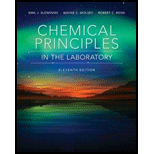
Concept explainers
Finding the density of a solid.
The student then emptied the flask and dried it once again. To the empty flask she added pieces of a metal until the flask was about three-fourths full. She weighed the stoppered flask and its metal contents and found that the mass was
a. To find the density of the metal we need to know its mass and volume. We can easily obtain its mass by the method of differences:
b. To determine the volume of metal, we note that the volume of the flask must equal the volume of the metal plus the volume of water in the filled flask containing both metal and water. If we can find the volume of water, we can obtain the volume of metal by the method of differences. To obtain the volume of the water we first calculate its mass:
The volume of water is found from its density, as in lb. Note that
c. From the volume of the water, we calculate the volume of metal:
From the mass and volume of metal, we find the density, using the equation in 1b. Make the calculation.
Trending nowThis is a popular solution!

Chapter 1 Solutions
Chemical Principles in the Laboratory
 ChemistryChemistryISBN:9781305957404Author:Steven S. Zumdahl, Susan A. Zumdahl, Donald J. DeCostePublisher:Cengage Learning
ChemistryChemistryISBN:9781305957404Author:Steven S. Zumdahl, Susan A. Zumdahl, Donald J. DeCostePublisher:Cengage Learning ChemistryChemistryISBN:9781259911156Author:Raymond Chang Dr., Jason Overby ProfessorPublisher:McGraw-Hill Education
ChemistryChemistryISBN:9781259911156Author:Raymond Chang Dr., Jason Overby ProfessorPublisher:McGraw-Hill Education Principles of Instrumental AnalysisChemistryISBN:9781305577213Author:Douglas A. Skoog, F. James Holler, Stanley R. CrouchPublisher:Cengage Learning
Principles of Instrumental AnalysisChemistryISBN:9781305577213Author:Douglas A. Skoog, F. James Holler, Stanley R. CrouchPublisher:Cengage Learning Organic ChemistryChemistryISBN:9780078021558Author:Janice Gorzynski Smith Dr.Publisher:McGraw-Hill Education
Organic ChemistryChemistryISBN:9780078021558Author:Janice Gorzynski Smith Dr.Publisher:McGraw-Hill Education Chemistry: Principles and ReactionsChemistryISBN:9781305079373Author:William L. Masterton, Cecile N. HurleyPublisher:Cengage Learning
Chemistry: Principles and ReactionsChemistryISBN:9781305079373Author:William L. Masterton, Cecile N. HurleyPublisher:Cengage Learning Elementary Principles of Chemical Processes, Bind...ChemistryISBN:9781118431221Author:Richard M. Felder, Ronald W. Rousseau, Lisa G. BullardPublisher:WILEY
Elementary Principles of Chemical Processes, Bind...ChemistryISBN:9781118431221Author:Richard M. Felder, Ronald W. Rousseau, Lisa G. BullardPublisher:WILEY





